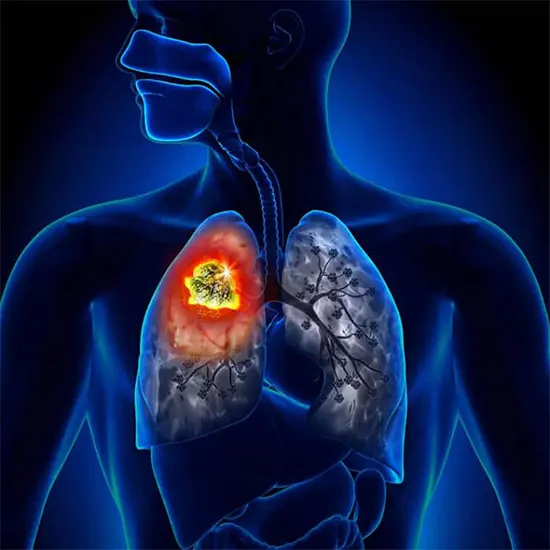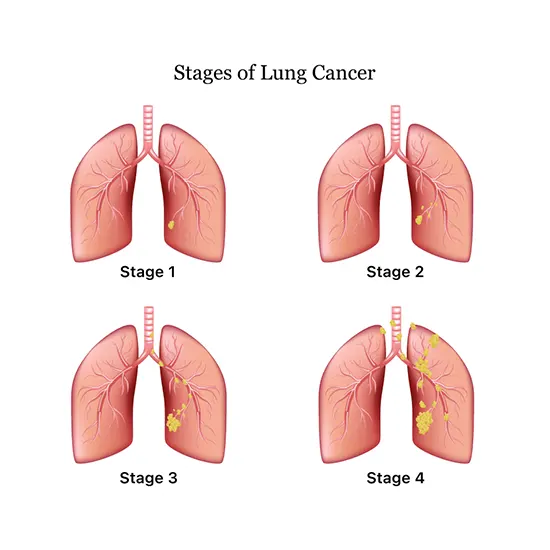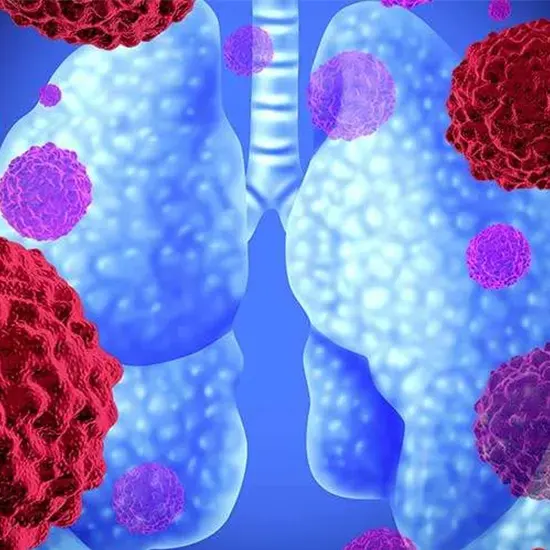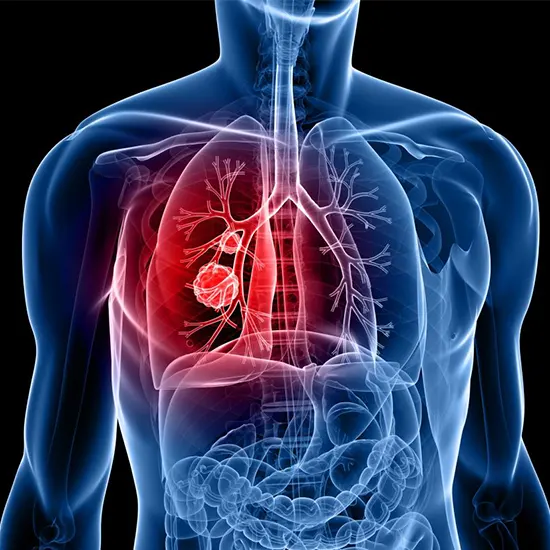.webp)
Lung cancer is a cancer type that develops in the lungs' tissues. It is the leading cause of cancer-related deaths worldwide compare to breast, colon, and prostate cancers combined. It is strongly associated with tobacco...
Lung cancer is a cancer type that develops in the lungs' tissues. It is the leading cause of cancer-related deaths worldwide compare to breast, colon, and prostate cancers combined. It is strongly associated with tobacco and smoking. Research says that 1 in 9 people in his/ her lifetime are likely to develop cancer. The rate of lung cancer development and the number of deaths due to lung cancer are rising but with early detection and advanced treatment, the death rate can be declined.
About Lung Cancer
Lung cancer is a cancer type that begins in the cells of the lungs and may spread to other body parts. This type of cancer occurs when there is an uncontrolled division of the cells in your lungs. Normally the cells of the lungs create a copy of themselves in a controlled manner but when any changes occur in the cells, the cells start dividing uncontrollably and creates abnormal masses or tumor.

The development of abnormal masses or tumor affect the normal functioning of the body's organs. The leading cause of lung cancer is smoking, which is responsible for about 80-85% of lung cancer cases. The risk of developing lung cancer increases with the number of cigarettes smoked per day and the duration of smoking, air pollution, radon gas, asbestos, and other carcinogens can also increase the risk of developing lung cancer. Genetic mutations and a family history of lung cancer may also increase the risk.
Types of Lungs Cancer
Here are 2 types of lung cancer
1. Non-Small Cell Lung Cancer (NSCLC)
2. Small Cell Lung Cancer (SCLC)
1. Non-Small Cell Lung Cancer (NSCLC)
Non-Small Cell Lung Cancer (NSCLC) accounts for approximately 85% of all lung cancers.
The subtypes of NSCLC are
- Adenocarcinoma: This is the most common type of NSCLC, accounting for about 40% of all lung cancer. It typically begins in the cells that line the air sacs and produces mucus.
- Squamous Cell Carcinoma: This type of NSCLC accounts for about 25-30% of all cancers. It typically begins in the cells that line the airways of the lungs and is often associated with smoking.
- Large Cell Carcinoma: This is a less common type of NSCLC accounting for about 10-15% of all cases. It can develop in any portion of the lung and grow rapidly.
2. Small Cell Lung Cancer (SCLC)
This type of cancer accounts for about 15% of all kinds of lung cancers. It tends to grow and spread quickly and is often associated with smoking. SCLC is divided into two stages:
- Limited Stage: It is confined to one lung and nearby lymph nodes.
- Extensive Stage: It spreads to other body parts.
Stages of Lungs Cancer
All type of cancers is staged based on the size and spread of the tumor. At every stage, the size and area of the spread change. The staging of lung cancer is important because it helps the doctor determine the best course of treatment for each patient.
The lungs cancer treatment options are such as: surgery, radiation therapy, chemotherapy, targeted therapy, etc. The best treatment plan depends on the stage and type of cancer, as well as the patient’s overall health and other factors.
There are five main stages of lung cancer, which are determined by the size and location of the cancer, as well as whether it has spread to nearby lymph nodes or other parts of the body. These stages are:

Stage 0 : At this stage, the cancer is in the bronchus and hasn’t spread outside of the lungs or any other organ.
Stage 1 : At this stage, the cancer is localized to the lungs and has not spread to nearby lymph nodes or other parts of the body. The tumor is usually small and can often be removed with surgery.
Stage 2 : At this stage, cancer may have grown larger and may have spread to nearby lymph nodes. The treatment at this stage may include surgical procedure, radiation therapy, or both.
Stage 3 : At this stage, cancer has typically spread beyond the lungs to other parts of the body, such as the lymph nodes or other nearby organs. Treatment of lung cancer includes chemotherapy, radiation therapy or surgery.
Stage 4 : At this stage, cancer has spread to a distant part of the body, such as the brain, liver, or bones. Treatment options may focus on managing symptoms, and improving quality of the life, rather than curing cancer.
Symptoms of Lungs Cancer
Symptoms of Lungs Cancer can vary depending on the stage of cancer and other factors. Some people don’t have symptoms until cancer has advanced.

However, some common symptoms of Lungs Cancer Include:
- Persistent Coughing may produce phlegm (mucus) or blood and doesn’t go over away over time.
- Pain in chest area that usually become worse with deep breathing, coughing and even laughing.
- Shortness of breath, wheezing, or hoarseness.
- Unexplained weight loss
- Loss of appetite
- Chest Discomfort
- Fatigue or weakness
- Recurrent lungs infections
- Swelling in the face or neck
- Bone pain or headaches (if cancer has spread to the other parts of the body)
It is important to note that these symptoms may also be caused by other conditions, and having one or more of the symptoms doesn’t necessarily that a person has lung cancer. However, if someone experiences any of these symptoms, they should see a doctor for evaluation and possible testing. Early detection of lung cancer can improve treatment outcomes and increase the chances of a successful recovery.
Causes of Lung Cancer
The primary cause of lung cancer is tobacco smoke, including both smoking and exposure to second hand smoke. The chemicals in tobacco smoke can damage the DNA in the lung cells, and lead to mutation(Changes) that cause the cells to grow abnormally and uncontrolled. The uncontrolled growth of the cells forms a tumor.
Other factors that increase the risk of developing lung cancer are
- Exposure to radon gas, which can be found in some homes and workplaces
- Exposure to arsenic, chromium, and nickel
- Air pollution
- Exposure to other environmental toxins.
- Family history of lung cancer or other genetic factors.
- Previous radiation therapy in the chest
- Chronic obstructive pulmonary disease (COPD)
- Other lung related diseases
- History of any other cancer
Risk Factors
Several risk factors are associated with an increased likelihood of developing lung cancer, some of the most common risk factors include:
Smoking : Tobacco smoking is the primary reason of lung cancer. Cigarette smoking accounts for approximately 85% of all cases of lung cancer.
Second hand Smoke : Exposure to second hand smoke also known as passive smoke, can also increase the risk of developing lung cancer.
Radon Gas Exposure : Radon gas is a colourless and odourless gas that seeps into homes and buildings from the soil.
Occupational Exposure : Exposure to certain chemicals and substances at work such as asbestos, diesel exhaust, chromium, nickel, etc.
Family History : A family history of lung cancer may increase the risk of developing lung cancer.
Air Pollution : Exposure to high levels of air pollution, such as pollution from vehicle exhaust, and industrial emissions can increase the chance of developing lung cancer.
Previous Lung Disease : Individuals who have previously had lung diseases such as tuberculosis or chronic obstructive pulmonary disease (COPD) may have an increased risk of developing lung cancer.
It is important to note that not everyone who is exposed to those risk factors will develop lung cancer. Some patient who develops the cancer of lung may or may not have any known causes. Having one or more risk factors doesn’t mean that someone will develop lung cancer and some people who develop lung cancer may not have known risk factors. However, reducing exposure to known risk factors such as Tabaco smoke can significantly reduce the risk of developing cancer.
Benefits of early Detection of Lung Cancer
Early detection of lung cancer can provide several benefits such as:
Improved treatment outcomes
When lung cancer is detected early, it is often more treatable and can be cured or controlled with a higher success rate. Early-stage lung cancer is more likely to be treated with surgery or radiation therapy, which can often result in a complete cure. In contrast, advanced-stage lung cancer is more difficult to treat and may require a combination of chemotherapy, radiation therapy, and/or targeted therapy.
Better quality of life
Early detection and treatment can help manage symptoms and improve the quality of life for people with lung cancer. By catching cancer early, doctors can work to prevent or reduce symptoms such as coughing, shortness of breath, and fatigue, which can significantly impact the quality of life.
Reduced healthcare costs
Early detection and treatment of lung cancer can also help reduce healthcare costs by avoiding the need for more aggressive and expensive treatments that may be necessary for advanced stages of the disease. Treating lung cancer early can also help prevent hospitalizations and emergency room visits.
Increased survival rates
The earlier lung cancer is detected and treated, the higher the chance of survival. In some cases, early detection can lead to a complete cure.
Overall, early detection of lung cancer is crucial for improving outcomes and quality of life for people with this disease. Regular screenings and prompt medical attention for any symptoms of lung cancer can help catch the disease early and increase the chances of a successful recovery.
Diagnosis of Lung Cancer
Diagnosis of lung cancer typically involves imaging tests combination of various tests such as X-rays, CT scans, and pet scans, as well as tissue biopsies. Treatment varies depending on both staging as well as cancer type includes surgery, radiation therapy, chemotherapy, targeted therapy, and immunotherapy.
Diagnostic tests are a critical part of diagnosing lung cancer. It can help the doctor identify the presence of a tumor in the lung and determine its size, location, and whether it has spread to other parts of the body. Your doctor will determine the best imaging tests for your specific situation based on your individual needs and medical history.
Tests to diagnose Lung Cancer
Sputum Test
This test is usually ordered when a patient has a cough and continuously produces sputum. To determine the presence of lung cancer cells, sputum is looked at under a microscope.
Biopsy
A biopsy involves removing a small sample of tissue from the tumor and examining it under a microscope to determine whether it is cancerous. There are various ways to perform a biopsy such as Needle Biopsy, Bronchoscopy, Mediastinoscopy, Thoracentesis, etc.
Imaging Tests
Imaging tests can help doctors identify the presence of a tumor in the lung and determine its size, location, and whether it has spread to other parts of the body.

Here are the most commonly used imaging tests for lung cancer:
Chest X-Ray : Chest X-rays are often the first test used to look for signs of lung cancer. x-rays use low doses of radiation to create images of the inside of the chest. If a suspicious spot is detected on an X-ray, further tests may be recommended.
Endobronchial Ultrasound (EBUS) : This is a highly effective diagnostic procedure for the diagnosis of different types of lungs related disorders such as lung inflammation, lung cancer, lung infection, etc.
Computed tomography (CT) scans : CT scans use a series of X-rays to create detailed images of the inside of the body. A CT scan of the chest can help detect small tumors in the lungs and can also help determine whether cancer has spread to other parts of the body.
Magnetic resonance imaging (MRI) : MRI scans use strong magnetic fields and radio waves to create detailed images of the inside of the body. MRI Scans may be used to provide more detailed information about the size and location of a lung tumor, as well as to check for the spread of cancer to other parts of the body.
Whole Body Positron emission tomography (PET) scans : PET scans use a small amount of radioactive material to help identify areas of the body where cells are dividing rapidly, such as cancer cells. whole body pet scan are used in combination with CT scans to help determine the stage of lung cancer and the best course of treatment.
Bone scans : Bone scans are used to check for cancer that may have spread to the bones. During a bone scan, a small amount of radioactive material is injected into the body, which collects in areas of the bones that are undergoing rapid cell growth.
In some cases, doctors may also perform other tests to evaluate lung function, such as pulmonary function tests, which can help determine how well the lungs are working.
Prevention of Lung Cancer
Prevention of lung cancer involves avoiding tobacco smoke, including secondhand smoke, and limiting exposure to other harmful substances such as asbestos and radon. Quitting smoking can also reduce the risk of developing lung cancer, as well as other health problems.
Conclusion
Lung cancer starts in the lungs. It usually occurs when the cells in the lungs mutate and start growing uncontrollably and forming a tumor. Early diagnosis is the key to the successful treatment of lung cancer. So, if you are experiencing the symptoms such as persistent cough, chest pain, or shortness of breath, it’s good to see the doctor right away.









